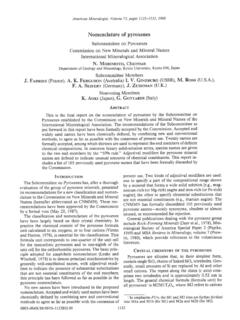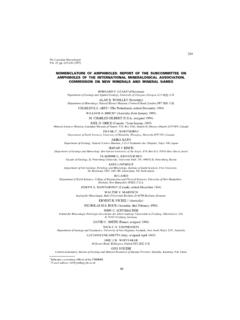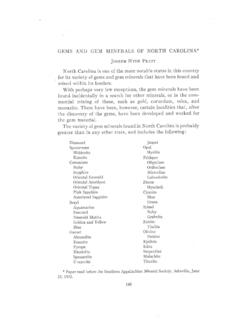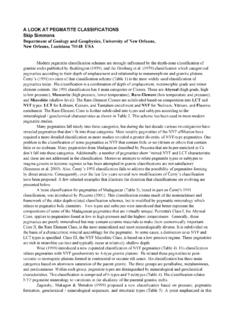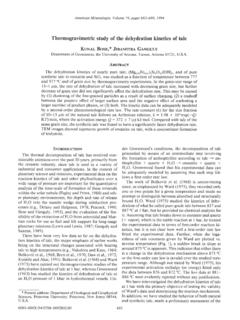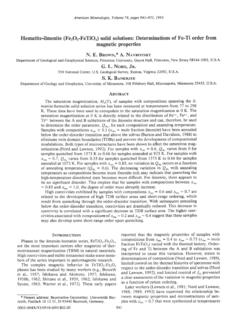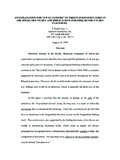Transcription of Opaque mineralogy and mafic mineral chemistry of I- and S ...
1 American Mineralogist, Volume 73, pages 281-296, 1988 Opaque mineralogy and mafic mineral chemistry of I- and S-type granites of theLachlan fold belt. southeast Australia*Josnpn B. Wrrer,nNGeological Survey of Canada,60l Booth Street, Ottawa, Ontario KIA 0E8, CanadaBnucn W. Crrappnr,r,Department of Geology, The Australian National University, Box 4, Canberra, 2600, AustraliaAnstnacrAbout one-quarter or 44000 km'z of the Lachlan fold belt of southeast Australia isunderlain by granite batholiths of Silurian-Devonian age. Recent work has recognized amajor distinction between granites formed from igneous sources (I-type) and those formedfrom sedimentary sources (S-type). Lachlan I- and S-type granites are generally character-ized by the Opaque mineral assemblages magnetite + ilmenite f minor sulfide (pyrite >chalcopyrite > pyrrhotite) and ilmenite * sulfide (pyrrhotite > pyrite > chalcopyrite),respectively.
2 There are, however, magnetite-free I-type and magrretite-bearing S-type gran-ites. Texturally earlier Opaque phases are generally magnetite + ilmenite in I-type andilmenite + sulfides in S-type granites. Sulfide minerals, even when abundant (rarely) inI-type granites, are texturally late phases. On the basis of rock chemistry , Opaque mineralassemblages, and mafic mineral chemistry , most Lachlan S-type granites formed at lower,fo, conditions than most Lachlan I-type granites. The higher sulfide content of S-typegranites and their reduced nature may reflect the sulfur and carbon content oftheir sedi-mentary source rocks. The plutonic Opaque mineral assemblage is another useful I- andS-type discriminator; however, the Fe-Ti oxide assemblage alone is of the magnetite- and ilmenite-series classification, developed from workon Japanese granites, has shown that I- and S-type granites may belong to either themagnetite or ilmenite series.
3 However, the bulk of I-type granites are magnetite series,and the bulk of S-type granites are ilmenite series. The fo, in a granitic magma may bemore important than the nature of the granitic source rocks in controlling the type ofassociated mineral the past 20 years, large-scale surveys of opaqueminerals in granites have been mainly limited to the workon Japanese granites by Ishihara and coworkers (Tsusueand Ishihara,19741, Ishihara, 1977, I98l), from whichthe descriptive magnetite- and ilmenite-series graniteclassification developed. Concurrently, during work ongranites of the Lachlan fold belt, Chappell, White, andcoworkers (Chappell and White, 1974; White etal.,1977b;Griffin etaI.,1978 White and Chappell, 1983) developedthe petrogenetic I- and S-type granite classification. Therelationship between these two granite classifications hasbeen a subject ofsome interest and speculation (Ishihara,1978, l98l;Takahashi et al.)
4 , 1980). This sysrematic sur-vey of Opaque mineral assemblages and mafic mineralchemistry, in the same specimens from which the I- andS-type granite classification was developed, was under-taken to clarify this situation. In addition, such a studyof mafic silicates and Opaque minerals can indicate rela-tive oxidation states within granitic plutons ( , Cza-* Geological Survey ofCanada contribution no. {28 I $ 28rmanske and Wones, 1973; Mason, 1978) or betweengranite types ( , Czamanske et al., 198 l; Wones, 1981).This study of 23 I carefully selected granite and xenolithsamples (see Fig. I and Table l) was greatly facilitatedby an extensive pre-existing body ofgeologic, petrologic,modal, and chemical ,q,crcnouNoThat portion of the Tasman fold belt in southeasternAustralia bounded by the flat-lying Mesozoic and Ceno-zoic strala of the Murray, Great Artesian, and Sydneybasins is known as the Lachlan fold belt.}
5 Paleozoic sed-imentary rocks in the belt are intruded by Silurian toDevonian granite batholiths that occupy about one-quar-ter (44000 km,) of the belr (White et al., 1974). Felsicvolcanic rocks, presumably the extrusive equivalents ofthe granites, are an important component in the Silurian-Devonian sequences. Chappell and White (1974; Whiteand Chappell, 1977,1983; Chappell, 1978) have pro-posed a genetic subdivision of the granites-based onmany geologic, mineralogic, chemical, and isotopic cri-teria-into those derived from igneous source rocks (I-type) and those derived from sedimentary source rocks282 WHALEN AND CHAPPELL: ACCESSORY MINERALS IN I- AND S-TYPE GRANITESFig. l. Location ofdiferent I- and S-type granitoid suites and Opaque mineral samples (I-type : filled triangles; S-type : filledcircles) in part of the l,achlan fold belt.
6 The main batholiths are numbered in the insert on the upper right: (1) Moruya, (2)Bega'(3) Berridale, (4) Murrumbidgee, (5) Kosciusko, (6) Maragle. Theshown with different patterns and numbered in circles: (l) BingiBrogo (I), (6) Kameruka (I), (7) Bemboka (I), (8) Candelo (I), (9)(13) Glenbog (I), (14) Clear Range (I), (15) Shannons Flat (S)' (lFinister (I), (20) Currowong (I), (21) Bullenbulong (S), (22) The C(l), (26) Green Hills (S), (2i)'(]rancoban (I). (Based on sources given in Table I and unpublished data of B. W. Chappell')Moruya, Bega, Berridale, Murrumbidgee, Kosciusko, andMaragle batholiths (Fig. I and Table 1). The granitoidshave been subdivided, on the basis of geochemical andgeologic data, into intrusive suites, the differences be-tween which are thought to reflect differences in theirrespective source restite model of White and Chappell (1977) hasbeen central to various studies on the Lachlan I- andS-t1pe granites ( , Compston and Chappell, 1979).))
7 Mostgranites are interpreted to be mixtures of crystallized meltand recrystallized refractory material (restite) that wasnot melted when the magma formed by partial inclusions (microgranitoid enclaves), anhedral maf-ic mineral aggregates (microxenoliths), and the cores ofmantled plagioclase crystals are interpreted as recogniz-able restite components of granites' An alternative inter-(S-type). A few pertinent features are that amphibole andaccessory primary titanite are restricted to I-type , often altered, is ofwidespread occurrence inS-type granites. Apatite occurs as small acicular crystalsin the mafic minerals of I-type granites and as discreteprismatic crystals in S-type granites. The oxidation stateof Fe is relatively low in S-type granites (Flood and Shaw,1975; Whire et al., 1977b).The distribution of both I- and S-type granites in theLachlan fold belt is apparently controlled by a geologic(lower crustal?)
8 Feature fotlowing a line east of Canberraand Cooma that extends to the south through the Berri-dale batholith (Fig. l). No S-type granites are known tothe east of this line. S-type granites are dominant to thewest, but I-type granites do occur sporadically. Withinthe Lachlan fold belt, samples were examined from theWHALEN AND CHAPPELL: ACCESSORY MINERALS IN I- AND S-TYPE GRANITES283 Trele 1. Aspects of studied Lachlan fold belt bathotithsBatholithsSize (km,) Granite type (%) Types of l-type100 S-type50 l-type50 S-type10 l-type90 S-type1 0 l-type90 S-type18G; 1X55G; 3X19G36G; 6X18G; 6X25c17G14G8G25077001 4001 53040003000 Griffen et al. (1978)Chappell and White (1976); Beams (1979, 1980)Snelling (1960); Joyce (1973a, 1973b)Chappell and White (1976); Williams et al. (1976); White elal. ('l977bl; White and Chappell (1981)white et al.)
9 (1977b); wyborn (1977); Hine et ar. (1978)Wyborn (1977); Wyborn and Chappell (1979)t Studied for Opaque minerals; G : granite sample, and X = xenolith , proposed by Vernon (1983, 1984), is that themicrogranitoid enclaves represent globules of more rnaficmagma that have mingled and quenched in the host gran-rte magma. Vernon (1984) concluded that microstruc-tural evidence for restite in granites is meager. The sub-ject continues to be controversial, for unequivocalevidence for one ofthese interpretations versus the othersis difficult to ,lpHrc AND MrNERAL ocrc DESCR rprroNS oFTHE Opaque MINERALSThe textural features ofthe Opaque minerals describedin the following section can be generally classed as ..ear-lier" or "later." Phases that can be identified as beingparagenetically "later" are mainly the products of the su-perimposed processes of replacement, exsolution, oxida-tion, silicate mineral reactions, and alteration.
10 '.Earlier" Opaque minerals, which comprise the bulk, by volume,of the Opaque minerals present in granites, may reflectdirect crystallization from a melt, incorporation of restiteor source material, and/or mafic silicate mineral reactionsor compositional changes within a magma. The main tex-tural features of the Opaque minerals are presented inFigures 2,3, and generally occurs (l) as inclusions in amphi-bole and biotite aggregates and in plagioclase cores and(2) as separate grains or aggregates (Fig. 2a). Furthermore,it commonly is associated with ilmenite grains and con-tains acicular apatite inclusions. Small magnetite inclu-sions occurring in quartz and plagioclase rims may rep-resent a later generation ofmagnetite than that containedin mafic silicates. In non-minimum melt granites, ,the Jindabyne suite, magnetite lacks fine apatite inclu-sions and occurs as euhedral grains included in, and asanhedral grains between, quartz and plagioclase grains,rather than in mafic silicate aggregates.
